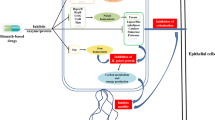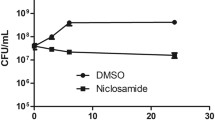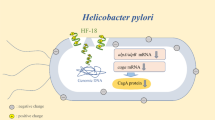Abstract
Bismuth drugs have been used clinically to treat infections from Helicobacter pylori, a pathogen that is strongly related to gastrointestinal diseases even stomach cancer. Despite extensive studies, the mechanisms of action of bismuth drugs are not fully understood. Alkyl hydroperoxide reductase subunit C (AhpC) is the most abundant 2-cysteine peroxiredoxin, crucial for H. pylori survival in the host by defense of oxidative stress. Herein we show that a Bi(III) antiulcer drug (CBS) binds to the highly conserved cysteine residues (Cys49 and Cys169) with a dissociation constant (K d) of Bi(III) to AhpC of 3.0 (±1.0) × 10−24 M. Significantly the interaction of CBS with AhpC disrupts the peroxiredoxin and chaperone activities of the enzyme both in vitro and in bacterial cells, leading to attenuated bacterial survival. Moreover, using a home-made fluorescent probe, we demonstrate that Bi(III) also perturbs AhpC relocation between the cytoplasm and membrane region in decomposing the exogenous ROS. Our study suggests that disruption of redox homeostasis by bismuth drugs via interaction with key enzymes such as AhpC contributes to their antimicrobial activity.





Similar content being viewed by others
References
Morones-Ramirez JR, Winkler JA, Spina CS, Collins JJ (2013) Silver enhances antibiotic activity against gram-negative bacteria. Sci Transl Med 5:190ra181
Dore MP, Lu H, Graham DY (2016) Role of bismuth in improving Helicobacter pylori eradication with triple therapy. Gut 65:870–878
Marshall BJ, Goodwin CS, Warren JR, Murray R, Blincow ED, Blackbourn SJ, Phillips M, Waters TE, Sanderson CR (1988) Prospective double-blind trial of duodenal ulcer relapse after eradication of Campylobacter pylori. Lancet 2:1437–1442
Fock KM, Graham DY, Malfertheiner P (2013) Helicobacter pylori research: historical insights and future directions. Nat Rev Gastroenterol Hepatol 10:495–500
Li H, Sun H (2012) Recent advances in bioinorganic chemistry of bismuth. Curr Opin Chem Biol 16:74–83
Polk DB, Peek RM Jr (2010) Helicobacter pylori: gastric cancer and beyond. Nat Rev Cancer 10:403–414
Yamaoka Y (2010) Mechanisms of disease: Helicobacter pylori virulence factors. Nat Rev Gastroenterol Hepatol 7:629–641
Megraud F (2012) The challenge of Helicobacter pylori resistance to antibiotics: the comeback of bismuth-based quadruple therapy. Ther Adv Gastroenterol 5:103–109
Malfertheiner P (2010) Infection—bismuth improves PPI-based triple therapy for H. pylori eradication. Nat Rev Gastroenterol Hepatol 7:538–539
Laine L, Hunt R, El-Zimaity H, Nguyen B, Osato M, Spenard J (2003) Bismuth-based quadruple therapy using a single capsule of bismuth biskalcitrate, metronidazole, and tetracycline given with omeprazole versus omeprazole, amoxicillin, and clarithromycin for eradication of Helicobacter pylori in duodenal ulcer patients: a prospective, randomized, multicenter, North American trial. Am J Gastroenterol 98:562–567
Cun S, Sun H (2010) A zinc-binding site by negative selection induces metallodrug susceptibility in an essential chaperonin. Proc Natl Acad Sci USA 107:4943–4948
Xia W, Li H, Sun H (2014) Functional disruption of HypB, a GTPase of Helicobacter pylori, by bismuth. Chem Commun 50:1611–1614
Cun SJ, Li HY, Ge RG, Lin MCM, Sun HZ (2008) A histidine-rich and cysteine-rich metal-binding domain at the C terminus of heat shock protein A from Helicobacter pylori—implication for nickel homeostasis and bismuth susceptibility. J Biol Chem 283:15142–15151
Ge R, Zhang Y, Sun X, Watt RM, He QY, Huang JD, Wilcox DE, Sun H (2006) Thermodynamic and kinetic aspects of metal binding to the histidine-rich protein, Hpn. J Am Chem Soc 128:11330–11331
Zhang L, Mulrooney SB, Leung AF, Zeng Y, Ko BB, Hausinger RP, Sun H (2006) Inhibition of urease by bismuth(III): implications for the mechanism of action of bismuth drugs. Biometals 19:503–511
Wang Y, Tsang CN, Xu F, Kong PW, Hu L, Wang J, Chu IK, Li H, Sun H (2015) Bio-coordination of bismuth in Helicobacter pylori revealed by immobilized metal affinity chromatography. Chem Commun 51:16479–16482
Ge R, Sun X, Gu Q, Watt RM, Tanner JA, Wong BC, Xia HH, Huang JD, He QY, Sun H (2007) A proteomic approach for the identification of bismuth-binding proteins in Helicobacter pylori. J Biol Inorg Chem 12:831–842
Stent A, Every AL, Sutton P (2012) Helicobacter pylori defense against oxidative attack. Am J Physiol Gastrointest Liver Physiol 302:G579–G587
Bryk R, Griffin P, Nathan C (2000) Peroxynitrite reductase activity of bacterial peroxiredoxins. Nature 407:211–215
Chuang M-H, Wu M-S, Lo W-L, Lin J-T, Wong C-H, Chiou S-H (2006) The antioxidant protein alkylhydroperoxide reductase of Helicobacter pylori switches from a peroxide reductase to a molecular chaperone function. Proc Natl Acad Sci USA 103:2552–2557
Baker LM, Raudonikiene A, Hoffman PS, Poole LB (2001) Essential thioredoxin-dependent peroxiredoxin system from Helicobacter pylori: genetic and kinetic characterization. J Bacteriol 183:1961–1973
Wang G, Olczak AA, Walton JP, Maier RJ (2005) Contribution of the Helicobacter pylori thiol peroxidase bacterioferritin comigratory protein to oxidative stress resistance and host colonization. Infect Immun 73:378–384
Huang CH, Chuang MH, Lo WL, Wu MS, Wu YH, Wu DC, Chiou SH (2011) Alkylhydroperoxide reductase of Helicobacter pylori as a biomarker for gastric patients with different pathological manifestations. Biochimie 93:1115–1123
Jang HH, Lee KO, Chi YH, Jung BG, Park SK, Park JH, Lee JR, Lee SS, Moon JC, Yun JW, Choi YO, Kim WY, Kang JS, Cheong GW, Yun DJ, Rhee SG, Cho MJ, Lee SY (2004) Two enzymes in one; two yeast peroxiredoxins display oxidative stress-dependent switching from a peroxidase to a molecular chaperone function. Cell 117:625–635
Moon JC, Hah YS, Kim WY, Jung BG, Jang HH, Lee JR, Kim SY, Lee YM, Jeon MG, Kim CW, Cho MJ, Lee SY (2005) Oxidative stress-dependent structural and functional switching of a human 2-Cys peroxiredoxin isotype II that enhances HeLa cell resistance to H2O2-induced cell death. J Biol Chem 280:28775–28784
Hu L, Cheng T, He B, Li L, Wang Y, Lai Y-T, Jiang G, Sun H (2013) Identification of metal-associated proteins in cells by using continuous-flow gel electrophoresis and inductively coupled plasma mass spectrometry. Angew Chem Intl Ed 52:4916–4920
Bai YC, Wu FC, Liu CQ, Li W, Guo JY, Fu PQ, Xing BS, Zheng J (2008) Ultraviolet absorbance titration for determining stability constants of humic substances with Cu(II) and Hg(II). Anal Chim Acta 616:115–121
Nelson KJ, Parsonage D (2011) Measurement of peroxiredoxin activity. Curr Protoc Toxicol 49:7.10.1–7.10.28
Steede NK, Temkin SL, Landry SJ (2000) Assay of chaperonin-assisted refolding of citrate synthase. In: Schneider C (ed) Chaperonin protocols 2001/08/04 edn. Humana Press Inc., Totowa, pp 133–138
Wiech H, Buchner J, Zimmermann R, Jakob U (1992) Hsp90 chaperones protein folding in vitro. Nature 358:169–170
Datsenko KA, Wanner BL (2000) One-step inactivation of chromosomal genes in Escherichia coli K-12 using PCR products. Proc Natl Acad Sci USA 97:6640–6645
Baba T, Ara T, Hasegawa M, Takai Y, Okumura Y, Baba M, Datsenko KA, Tomita M, Wanner BL, Mori H (2006) Construction of Escherichia coli K-12 in-frame, single-gene knockout mutants: the Keio collection. Mol Syst Biol 2(2006):0008
Menard R, Sansonetti PJ, Parsot C (1993) Nonpolar mutagenesis of the ipa genes defines IpaB, IpaC, and IpaD as effectors of Shigella flexneri entry into epithelial cells. J Bacteriol 175:5899–5906
Carpenter BM, McDaniel TK, Whitmire JM, Gancz H, Guidotti S, Censini S, Merrell DS (2007) Expanding the Helicobacter pylori genetic toolbox: modification of an endogenous plasmid for use as a transcriptional reporter and complementation vector. App Environ Microbiol 73:7506–7514
Ge Z, Taylor DE (1997) H. pylori DNA transformation by natural competence and electroporation. In: Clayton CL, Mobley HLT (eds) Helicobacter pylori protocols. Humana Press, Totowa, pp 145–152
Chung KCC, Zamble DB (2011) Protein interactions and localization of the Escherichia coli accessory protein HypA during nickel insertion to [NiFe] hydrogenase. J Biol Chem 286:43081–43090
Lai Y-T, Chang Y-Y, Hu L, Yang Y, Chao A, Du Z-Y, Tanner JA, Chye M-L, Qian C, Ng K-M, Li H, Sun H (2015) Rapid labeling of intracellular His-tagged proteins in living cells. Proc Natl Acad Sci USA 12:2948–2953
Sun H, Li H, Harvey I, Sadler PJ (1999) Interactions of bismuth complexes with metallothionein(II). J Biol Chem 274:29094–29101
Ge R, Sun H (2007) Bioinorganic chemistry of bismuth and antimony: target sites of metallodrugs. Acc Chem Res 40:267–274
Parsonage D, Karplus PA, Poole LB (2008) Substrate specificity and redox potential of AhpC, a bacterial peroxiredoxin. Proc Natl Acad Sci USA 105:8209–8214
Dwyer DJ, Kohanski MA, Collins JJ (2009) Role of reactive oxygen species in antibiotic action and resistance. Curr Opin Microbiol 12:482–489
Wang G, Hong Y, Johnson MK, Maier RJ (2006) Lipid peroxidation as a source of oxidative damage in Helicobacter pylori: protective roles of peroxiredoxins. Biochim Biophys Acta 1760:1596–1603
Wood ZA, Schroder E, Robin Harris J, Poole LB (2003) Structure, mechanism and regulation of peroxiredoxins. Trends Biochem Sci 28:32–40
An BC, Lee SS, Lee EM, Lee JT, Wi SG, Jung HS, Park W, Chung BY (2010) A new antioxidant with dual functions as a peroxidase and chaperone in Pseudomonas aeruginosa. Mol Cells 29:145–151
Lundstrom AM, Bolin I (2000) A 26 kDa protein of Helicobacter pylori shows alkyl hydroperoxide reductase (AhpC) activity and the mono-cistronic transcription of the gene is affected by pH. Microb Pathog 29:257–266
Dwyer DJ, Belenky PA, Yang JH, MacDonald IC, Martell JD, Takahashi N, Chan CTY, Lobritz MA, Braff D, Schwarz EG, Ye JD, Pati M, Vercruysse M, Ralifo PS, Allison KR, Khalil AS, Ting AY, Walker GC, Collins JJ (2014) Antibiotics induce redox-related physiological alterations as part of their lethality. Proc Natl Acad Sci USA 111:E2100–E2109
Sobotta MC, Liou W, Stöcker S, Talwar D, Oehler M, Ruppert T, Scharf AN, Dick TP (2015) Peroxiredoxin-2 and STAT3 form a redox relay for H2O2 signaling. Nat Chem Biol 11:64–70
Teixeira F, Castro H, Cruz T, Tse E, Koldewey P, Southworth DR, Tomás AM, Jakob U (2015) Mitochondrial peroxiredoxin functions as crucial chaperone reservoir in Leishmania infantum. Proc Natl Acad Sci USA 112:E616–E624
Acknowledgements
This work was supported by the Research Grants of Council of Hong Kong (703913, 17304614, 17305415, 17333616), Livzon Pharmaceutical Group, the University of Hong Kong (for an emerging Strategic Research Theme on Integrative Biology). We thank the assistance of Li Ka Shing Faculty of Medicine Faculty Core Facility, The University of Hong Kong. We thank Prof. Patrick Chiu Yat Woo (Department of Microbiology, LKS Faculty of Medicine) for his generous offer of clinical isolate of H. pylori strain. We thank Dr. Ligang Hu for his helpful comments and suggestions and Dr. Yau-Tsz Lai for suggestions on microscopic analysis.
Author information
Authors and Affiliations
Corresponding authors
Electronic supplementary material
Below is the link to the electronic supplementary material.
Rights and permissions
About this article
Cite this article
Chang, YY., Cheng, T., Yang, X. et al. Functional disruption of peroxiredoxin by bismuth antiulcer drugs attenuates Helicobacter pylori survival. J Biol Inorg Chem 22, 673–683 (2017). https://doi.org/10.1007/s00775-017-1452-5
Received:
Accepted:
Published:
Issue Date:
DOI: https://doi.org/10.1007/s00775-017-1452-5




